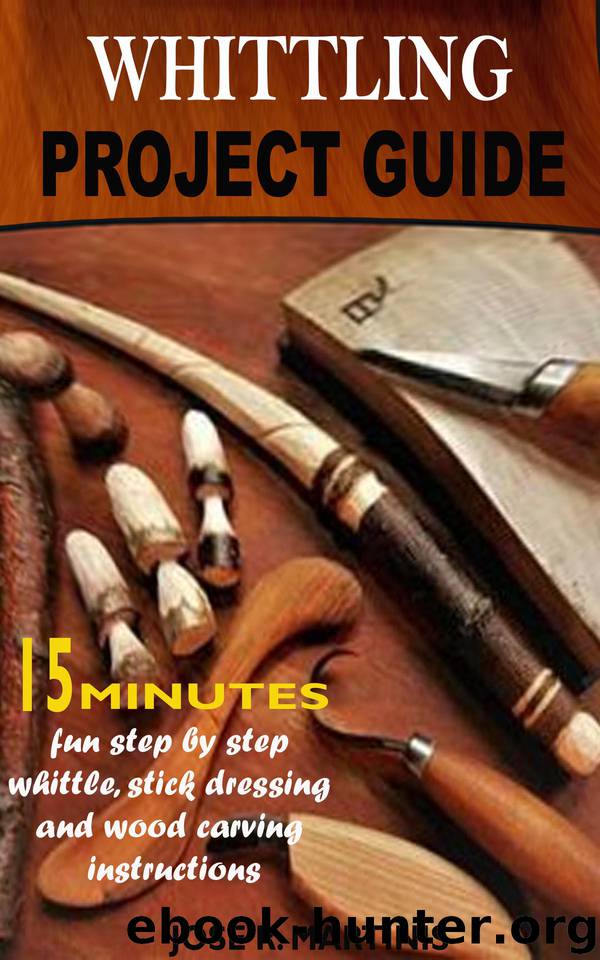WHITTLING PROJECT GUIDE: COMPLETE 15 MINUTES BEGINNER'S GUIDE WITH FUN STEP-BY-STEP WHITTLING, WOOD CARVING, AND STICK DRESSING INSTRUCTIONS. 2020 EDITION by MARTINIS JOSE R

Author:MARTINIS, JOSE R. [MARTINIS, JOSE R.]
Language: eng
Format: azw3, epub
Published: 2020-06-09T16:00:00+00:00
STEP 2: PRACTICE CUTS
PRACTICE WITH WOOD SCRAP.
It is always a good idea to practice a few basic cuts on scrap wood before working on important, useful pieces of wood. This gives you the opportunity to familiarize yourself with the tools. Also, be careful never to cut in the direction of your body. If the knife slips you will avoid an accident. Always use sharp tools, even when you are practicing. If the tools are sharp enough, they should make a clean, shiny cut through the wood without leaving scratches or scratches.
KEEP THE KNIFE CORRECT.
If you need to push a knife, gouge, or chisel through the wood, keep your hands behind the sharp edge. These tools can slip during work. If your fingers are in front of the blade, injury can result.
Grasp the wood with your non-dominant hand when working with knives. Hold your hand behind the tool blade, but gently press the thumb of your hand against the blunt side of the tool for easy control. While holding your non-dominant hand steady, rotate the dominant hand and wrist to achieve the cut you want.
When working with gouges, hold the handle in the palm of your dominant hand while stabilizing the shaft by pushing it between the thumb and index finger of your dominant hand. The edge must be against the wood.
Remember to control the direction of your carving tools with your wrist and not your elbow. This applies regardless of the cut or tool used.
CARVE ALONG THE GRAIN.
Always carve along with the grain instead of against it. If you cut against the grain, the wood may splinters.
Examine the wood and find the long, parallel lines that run through the wood. These lines may or may not be parallel to the sides of the plate and could be wavy rather than rigid straight.
Always carve down on these grain lines. You can also carve diagonally across the grain or in parallel, but not carve against the grain. If the wood starts to tear when it is carved, even if the tool is sharp, you may be carving in the wrong direction. Switch in the opposite direction and check the results again.
PRACTICE SOME BASIC CUTS.
There are numerous cuts you need to learn when practicing this craft, but when you start, you should practice at least some of the basics.
The running cut creates a long channel in the wood. Hold the blade of a U or V gouge against the surface of the wood and slide it over the grain to keep the pressure as even as possible.
A stabbing cut creates sharp carvings on the wood surface so you can create hard shadows. Slide the edge of a gouge straight into the wood and then pull it out without pushing it further.
Sweep cuts are long arch cuts. Use a gouge to push across the grain and twist the handle as you push it forward to create an arc.
Download
WHITTLING PROJECT GUIDE: COMPLETE 15 MINUTES BEGINNER'S GUIDE WITH FUN STEP-BY-STEP WHITTLING, WOOD CARVING, AND STICK DRESSING INSTRUCTIONS. 2020 EDITION by MARTINIS JOSE R.epub
This site does not store any files on its server. We only index and link to content provided by other sites. Please contact the content providers to delete copyright contents if any and email us, we'll remove relevant links or contents immediately.
On Writing A Memoir of the Craft by Stephen King(4863)
The Doodle Revolution by Sunni Brown(4685)
A Simplified Life by Emily Ley(4098)
Mummy Knew by Lisa James(3631)
Marijuana Grower's Handbook by Ed Rosenthal(3619)
Better Homes and Gardens New Cookbook by Better Homes & Gardens(3524)
Figure Drawing for Artists by Steve Huston(3381)
Paper Parties by Erin Hung(3370)
Draw Your Day by Samantha Dion Baker(3287)
The Genius of Japanese Carpentry by Azby Brown(3224)
Japanese Design by Patricia J. Graham(3109)
The Code Book by Simon Singh(3074)
Dangerous Girls by Haas Abigail(2976)
Lions and Lace by Meagan Mckinney(2923)
The Curated Closet by Anuschka Rees(2912)
How to Make Your Own Soap by Sally Hornsey(2827)
The Checklist Manifesto by Atul Gawande(2776)
The Wardrobe Wakeup by Lois Joy Johnson(2732)
Zero to Make by David Lang(2726)
